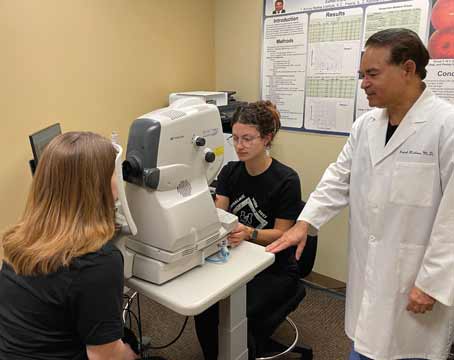|
The Disk
Dr. Newsom took to the task of devising a way to do at least some aspects of cataract surgery with the Intralase because he owns one himself. “There are something like 800 Intralase lasers out there in use in refractive surgery practices,” he observes. “I think the huge benefit of this technology used for cataract surgery is that the physician has already paid for [his Intralase]. It’s a part of his overhead.”
Dr. Newsom knew that the Intralase-enabled keratoplasty software could make a corneal incision of any dimension or angle, but it couldn’t make a cataract entry wound per se. “When you use the IEK software, the device will make an incision 360 degrees around,” Dr. Newsom explains. I had to figure out a way to make an incision that was only 2.5 mm wide.”
The method Dr. Newsom came up with is a small disk that fits into the bottom of the Intralase interface cone and acts as a mask for most of the 360-degree laser photodisruption except for the parts he wants to incise. The prototypes of the Newsom Bladeless Laser Disk were produced by Rhein Medical in Tampa, which worked extensively with Dr. Newsom. “The laser still goes 360 degrees, but with the disk in place it can only get past the disk for 2.5 mm where our incision is located, and 1 mm for our paracentesis.” The concept of masking the beam to make cataract incisions has also been validated by Nashville, Tenn., surgeon James Loden, who has used the Intralase for cataract incisions in his practice.
Dr. Newsom says the disk is designed to have a little play in it when it sits in the cone, rather than fit snugly. “We found that if you make it a little smaller there’s room to move it around and line it up with your incision location,” he says. “We use bent McPherson forceps to rotate it by grabbing it inside the incision opening. You move the laser position so it’s right on the limbus where you want it, then you can rotate the disk and block the areas you want to block.” Using the disk, Dr. Newsom can use his Intralase to make the entry incision, the paracentesis and limbal relaxing incisions (either intrastromal or combined with the entry wound). It doesn’t do the capsulotomy or nucleofractis.
|
Results and Logistics
Dr. Newsom has used the disk for about 20 patients so far and doesn’t report any issues. “We’ve been watching them closely to see what the change in astigmatism is,” he says. “Rather than just do it on everyone, we’re trying to find good, quality study patients. We’ve been doing optical coherence tomography of the incisions and they look good.
“We haven’t had any problems with the wounds sealing,” Dr. Newsom continues. “We’ve been erring on the side of caution and have been making a longer incision than the standard diamond-blade incision because we didn’t know about the effect of the intraocular pressure with a full-thickness incision.”
Dr. Newsom isn’t currently charging for the service, since the patients are agreeing to be part of his research protocol of the disk. In the future, however, he believes using the laser for an optional astigmatism treatment will be the main way to charge for it, since it won’t be done on the same day as the cataract procedure, and therefore won’t be mingled with Medicare’s payment for the actual surgery day itself. “Say you do LASIK on Tuesdays and cataract surgeries on Thursday,” Dr. Newsom posits. “You can bring in cataract patients on Tuesday, use the Intralase for their incisions and LRIs in the office, then leave the incisions alone and start the preop regimen. Then, you can bring them in two days later, go straight to the operating room, open the incisions and perform the cataract procedure. This relieves a number of billing issues because the entry incision and the LRI’s aren’t made during the actual cataract surgery. You’re essentially separating the parts that are pre-paid and done in an office setting and the parts that are paid for by Medicare.”
From a business perspective, Dr. Newsom thinks it will be more successful with patients who are getting monofocal lenses but can pay extra for Intralase LRIs, than premium lens patients. “You’ll have monofocal patients having femtosecond LRIs and paying a certain charge for that, which I think will be a better profit margin than trying to charge a patient who’s already paying extra for a premium IOL an extra $1,000 or $1,500. I don’t think these premium-IOL patients will pay that.”
Dr. Newsom says the next step is to work with Rhein on the best way to release the device, and to begin sharing details on the laser programming so surgeons can use their lasers for parts of the cataract surgery. “We’re very happy with the most recent design, and, though we may fine-tune it a little more, it can do everything we need it to do,” he says. “The second key to using it is the laser programming. We’ve been approved for a course at the upcoming ASCRS meeting where we’ll disclose all the step-by-step information on how we do it.”
REVIEW








